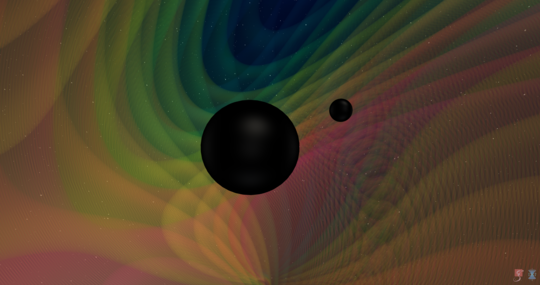The expectations of the gravitational-wave research community have been fulfilled: gravitational-wave discoveries are now part of their daily work as they have identified in the past observing run, O3, new gravitational-wave candidates about once a week. But now, the researchers have published a remarkable signal unlike any of those seen before: GW190412 is the first observation of a binary black hole merger where the two black holes have distinctly different masses of about 8 and 30 times that of our sun. This not only has allowed more precise measurements of the system’s astrophysical properties, but it has also enabled the LIGO and Virgo scientists to verify a yet-untested prediction of Einstein’s theory of general relativity.
Frank Ohme is leader of an independent research group at Max Planck called Binary Merger Observations and Numerical Relativity. He commented:
For the very first time we have ‘heard’ in GW190412 the unmistakable gravitational-wave hum of a higher harmonic, similar to overtones of musical instruments. In systems with unequal masses like GW190412 – our first observation of this type – these overtones in the gravitational-wave signal are much louder than in our usual observations. This is why we couldn’t hear them before, but in GW190412, we finally can.
This observation once again confirms Einstein’s theory of general relativity, which predicts the existence of these higher harmonics, i.e. gravitational waves at two or three times the fundamental frequency observed so far. Roberto Cotesta is a Ph.D. student in the Astrophysical and Cosmological Relativity division at the AEI in Potsdam. He said:
The black holes at the heart of GW190412 have 8 and 30 times the mass of our sun, respectively. This is the first binary black-hole system we have observed for which the difference between the masses of the two black holes is so large!
This big mass difference means that we can more precisely measure several properties of the system: its distance to us, the angle we look at it, and how fast the heavy black hole spins around its axis.
GW190412 was observed by both LIGO detectors and the Virgo detector on April 12, 2019, early during the detectors’ third observation run O3. Analyses reveal that the merger happened at a distance of 1.9 to 2.9 billion light-years from Earth. The new unequal mass system is a unique discovery since all binaries observed previously by the LIGO and Virgo detectors consisted of two roughly similar masses.
Unequal masses imprint themselves on the observed gravitational-wave signal, which in turn allow scientists to more precisely measure certain astrophysical properties of the system. The presence of higher harmonics makes it possible to break an ambiguity between the distance to the system and the angle we look at its orbital plane; therefore these properties can be measured with higher precision than in equal-mass systems without higher harmonics. Alessandra Buonanno is director of the Astrophysical and Cosmological Relativity division at the AEI in Potsdam. She said:
During [observing runs] O1 and O2, we have observed the tip of the iceberg of the binary population composed of stellar-mass black holes. Thanks to the improved sensitivity, GW190412 has begun to reveal us a more diverse, submerged population, characterized by mass asymmetry as large as 4 and black holes spinning at about 40% the possible maximum value allowed by general relativity.
AEI researchers contributed to detecting and analyzing GW190412. They have provided accurate models of the gravitational waves from coalescing black holes that included, for the first time, both the precession of the black-holes’ spins and multipole moments beyond the dominant quadrupole. Those features imprinted in the waveform [the wavelike pattern seen in observations of gravitational waves] were crucial to extract unique information about the source’s properties and carry out tests of general relativity. The high-performance computer clusters Minerva and Hypatia at AEI Potsdam and Holodeck at AEI Hannover contributed significantly to the analysis of the signal.

Testing Einstein’s theory
LIGO/Virgo scientists also used GW190412 to look for deviations of the signals from what Einstein’s general theory of relativity predicts. Even though the signal has properties unlike all others found so far, the researchers could find no significant departure from the general-relativistic predictions.
An improved international network of detectors using squeezed light
This discovery is the second reported from the third observation run (O3) of the international gravitational-wave detector network. Scientists at the three large detectors have made several technological upgrades to the instruments. Karsten Danzmann, director at the AEI Hannover and director of the Institute for Gravitational Physics at Leibniz University Hannover, said:
During [observing run] O3, squeezed light was used to enhance the sensitivity of LIGO and Virgo. This technique of carefully tuning the quantum-mechanical properties of the laser light was pioneered at the German-British detector GEO600 …
2 done, 54 on the to-do list
The detector network has issued alerts for 56 possible gravitational-wave events (candidates) in observing run O3 (April 1, 2019 to March 27, 2020, with an interruption for upgrades and commissioning in October 2019). Out of these 56, one other confirmed signal, GW190425, has already been published. LIGO and Virgo scientists are examining all remaining 54 candidates and will publish all those for which detailed follow-up analyses confirm their astrophysical origin.
The observation of GW190412 means that similar systems are probably not as rare as predicted by some models. Therefore, with additional gravitational-wave observations and growing event catalogues in the future, more such signals are to be expected. Each of them could help astronomers better understand how black holes and their binary systems are formed, and shed new light on the fundamental physics of space-time.

Bottom line: LIGO and Virgo detectors have now captured the first gravitational waves from a binary black hole merger where the black hole masses are unequal.











